- TOP
- Cutting-edge Research and Social Contribution
- Cutting-edge Research
- "CES structures" have both high earthquake resistance and outstanding buildability -- What are they?
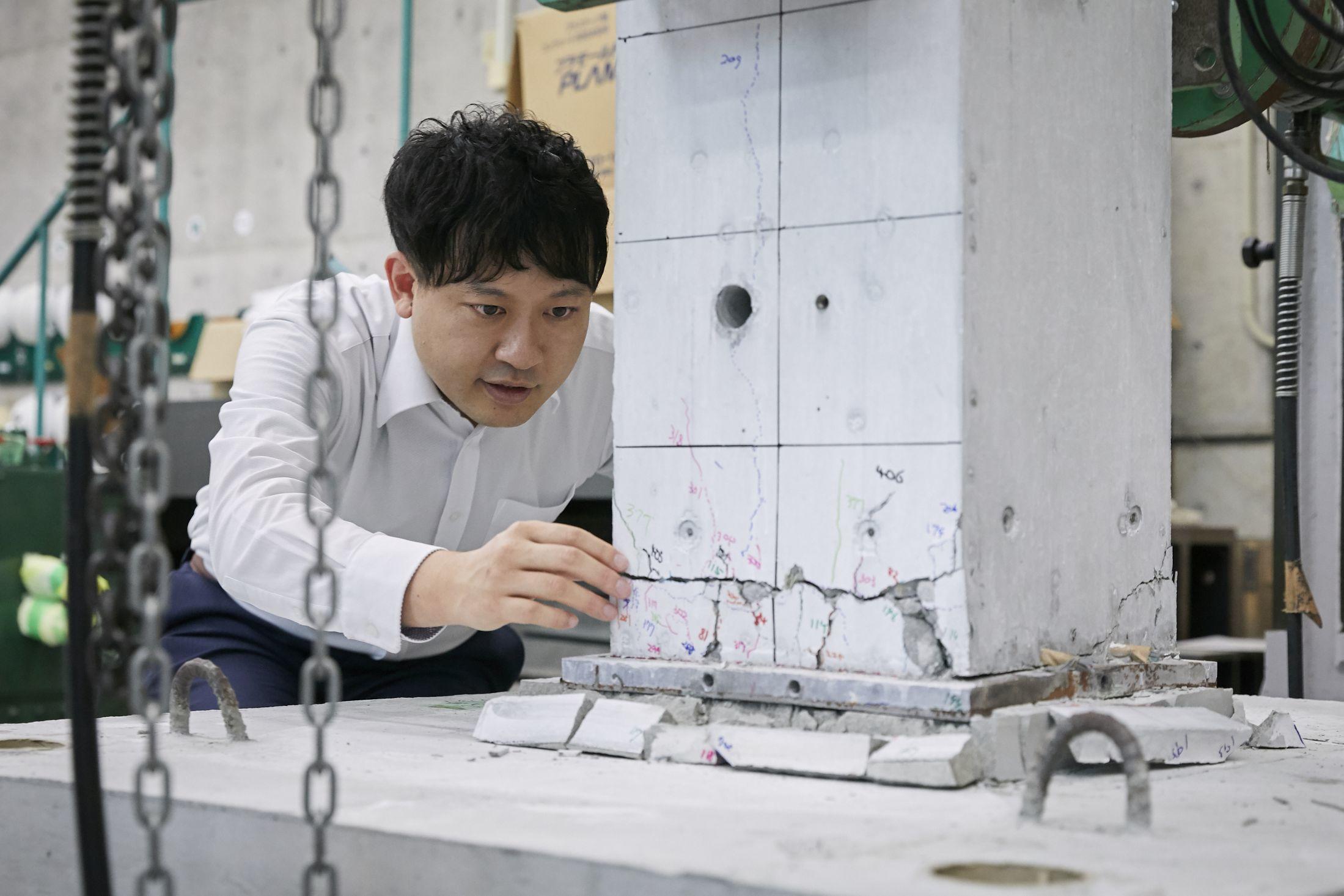
"CES structures" have both high earthquake resistance and outstanding buildability -- What are they?
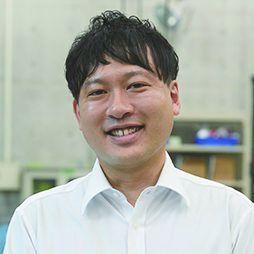
SUZUKI Suguru
- Specialized field
Reinforced Concrete Structure, Steel-Concrete Composite Structure, Seismic design
Establishing a next-generation type of architectural structure for use in Japan, a country known as the "Land of Earthquakes." Japan is a small island country whose land area is less than 0.25% of the world total, and yet about 20% of earthquakes of magnitude 6.0 or higher occur in and around Japan. There are also concerns about a massive earthquake in the near future, such as a Nankai Trough earthquake. To minimize earthquake damage, it will be increasingly important to develop, design, and build worry-free earthquake-resistant architectural structures. Another pressing issue will be securing future workers for construction sites as the working population continues to age.
Indicating a sound path towards practical use of CES structures
Even among people aware of reinforced concrete (RC) construction and steel (S) construction as building structure types, many have likely not heard of steel-framed reinforced concrete (SRC) construction, which combines RC and S construction. SRC construction was developed in Japan in the Taisho period, and evolved in a unique way. It has been used in large-scale buildings and high-rise buildings as an architectural structure with outstanding earthquake resistance. However, since 1990, there has been a rapid decline in the number of buildings constructed in Japan, mainly due to longer construction periods and higher costs driven by complicated design and construction. Still, the results of a survey of building damage caused by the 1995 Great Hanshin earthquake showed that the overall earthquake resistance performance of SRC construction was significantly better than other structures. Thus, R&D was started in 2001 in Japan on the CES structure, which consist only of a steel frame and fiber-reinforced concrete (FRC), as an architectural approach which achieves superior buildability while harnessing the high seismic resistance of SRC construction.
CES structure is especially suited to Japan, an earthquake-prone country where there are concerns about the shrinking working population. Dr. Suzuki got involved with this research around the first year of his Master's program. A teacher from his undergraduate days happened to be the originator of the CES structure, and he began experiments and analysis to evaluate structural performance--critical work for achieving practical use of the CES structure.
Thirteen years later, in May 2022, the book AIJ Guidelines for Structural Design of Concrete Encased Steel (CES) Buildings Based on Performance Evaluation Concept (Draft) was published by the Architectural Institute of Japan. This book was written collaboratively by Dr. Suzuki and his colleagues, and presents a well-defined roadmap towards practical use of CES structures.
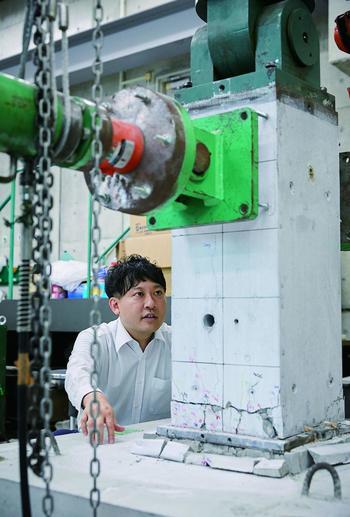
First to clarify the structural performance of column bases in CES structures
Amid high expectations for future dissemination of the CES structure, Dr. Suzuki looked at the "column base part," the boundary between the building and foundation. This was a point that had previously lacked thorough verification. He is currently analyzing dynamic properties, from cracking to failure, and researching the earthquake resistance performance of buildings by using the dynamic characteristics of structure performance.
CES structures with encased steel have two column base types, depending on whether the steel frame is embedded in the foundation structure. The non-embedded type is superior to the embedded type in terms of buildability, but earthquake resistance is far inferior to the embedded type, so each type has both advantages and disadvantages.
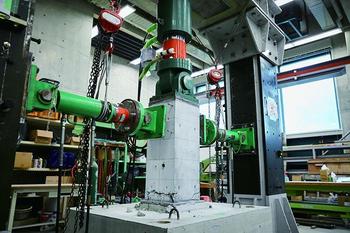
Dr. Suzuki began with a structure experiment. The aim was to observe cracking after applying forces simulating earthquake motion to an embedded-type test specimen. The results confirmed that: first, the shallower the depth of embedding, the lower the resistance to shearing force, and second the magnitude of the resistance force differs depending on whether or not there is a base plate supporting the embedded steel frame. This work showed, for the first time, the structural performance of embedded column bases in a CES structure.
Next, in order to improve earthquake-resistance with the non-embedded type, Dr. Suzuki carried out structural experiments by fabricating a test specimen with anti-slip reinforcement on the underside of the base plate. The results here confirmed that anti-slip reinforcement improved resistance to shearing force, but there was damage to foundation concrete on the side surface of the test specimen, so the approach had disadvantages rather than advantages.
Researchers, like Dr. Suzuki, who are doing both experimental and analytic research in the field of seismic engineering are unusual, and he sees this as one of his strengths. "By conducting research from both experimental and analytic perspectives, I'm not limited to theoretical calculations. I can also experimentally demonstrate force flows and resistance in concrete in response to earthquake motion, and numerically express previously considered hypotheses"
In each experiment on column bases, he also observed the maximum force the structure can bear without failing, and he is developing those results into proposal of member bearing capacity evaluation formulas necessary for designing CES structures.
Encountering CES structures shaped his research life
Dr. Suzuki aims to advance seismic engineering in Japan, and he is working on many themes aside from this research. One example is a system he has built to enable visualization of the concrete cracking of an entire building, which occurs in an earthquake, by using high-resolution photo data from before and after deformation. This system also enables automatic determination of the degree of damage.
Dr. Suzuki is from Shizuoka Prefecture, an area likely to be struck by a Nankai Trough earthquake. There were periodic disaster drills from the time he was in elementary school, and disaster-safety hoods on every student's chair. He had many opportunities to think about earthquakes due to the vulnerability of his home region. He also accompanied his grandfather, a tatami maker, and often saw local homes under construction, and this influenced him in choosing the path of earthquake-resistant design which combines earthquakes and architecture. Looking back on his research activities, he says "My encounter with CES structures has shaped my life."
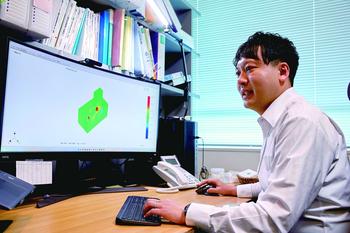
"Few people are researching CES structures, so the more I work, the more results I can produce. I can do research with the enthusiasm of establishing a new structure type in the world, and that's a big motivation."
When we hear the term "architectural design," people tend to think of the artistic side of design, but Dr. Suzuki wants his students to be strong structure designers. Here, we can see his ideas in a nutshell: "We're doing architecture in Japan, so we can't get away from structural issues."
Date of posting: March, 2024/ Date of interview: July, 2023
